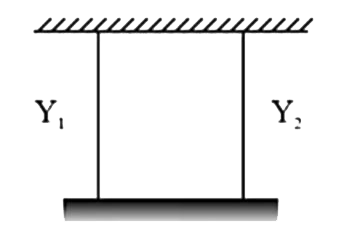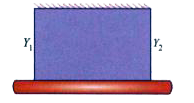Two wires of equal length and cross-sectional area are suspended as shown in figure. Their Young's modullare Y1 andY2 respectively. The equivalent Young's modulil will bebr>
Y1+Y2
Y1+Y22
Y1Y2Y1+Y2
√Y1Y2
The correct Answer is:B

Given that the wires have equal length and cross section We know that
F=KΔX
Where K is spring constant
Let K1andK2 be the spring constants of the two wires.
∴K=FΔL=YAL
therefore equivalent spring constant (Keq)
Keq=K1+K2
Yeq×2AL=Y1AL1+Y2AL2
Here L1 and L2 are equal
∴Yeq2AL=AL(Y1+Y2)
⇒Yeq=Y1+Y22
Topper's Solved these Questions
Similar Questions
Two wires of equal length and cross sectional area suspended as shown in

Their Young's modulii are Y1=2×1011 Pa and Y2=0.90×1011 Pa respectively. What will be the equivalent Young's modulus of combination?
View SolutionA horizontal rod suspended from two wires of same length and cross - section. Their Young's modulus are Y1 and Y2 respectively. The equivalent Young's modulus will be

View Solution
Knowledge Check
Two wires of equal length and cross-sectional area are suspended as shown in figure. Their Young's modullare Y1 andY2 respectively. The equivalent Young's modulil will bebr>
 AY1+Y2BY1+Y22CY1Y2Y1+Y2D√Y1Y2
AY1+Y2BY1+Y22CY1Y2Y1+Y2D√Y1Y2Two wires of equal length and cross-section area suspended as shown in figure. Their Young's modulus are Y1 and Y2 respectively. The equavalent Young's modulus will be
 AY1+Y2BY1−Y22CY1Y2Y1+Y2D√Y1Y2
AY1+Y2BY1−Y22CY1Y2Y1+Y2D√Y1Y2Two wires of different materials each of length l and cross sectional area 'A' are joined in series to form a composite wire. If their young's moduli are Y and 2Y, the total elongation produced by applying a force F to stretch the composite wire will be
A3FA2YlB2FA3YlC2FA3AYD3Fl2AY
Two wires have identical lengths and areas of cross-section are suspended by mass M. Their Young's modulus are in the ratio 2:5.
View SolutionA wire of length l and cross-sectional are A is suspended at one of its ends from a ceiling. What will be its strain energy due to its own weight, if the density and Young's modulus of the material of the wire be d and Y?
View SolutionA wire having a length L and cross- sectional area A is suspended at one of its ends from a ceiling . Density and young's modulus of material of the wire are ρ and Y, respectively. Its strain energy due to its own weight is ρ2g2AL3αY. Find the value of α
View SolutionA wire of length L and cross-sectional area A is made of material of Young's modulus Y. The work done in stretching the wire by an amount x is
View SolutionTwo springs of equal lengths and equal cross sectional area are made of materials whose young's moduli are in the ratio of 3 : 2. They are suspended and loaded with the same mass. When stretched and released, they will oscillate with time period in the ratio of
View Solution
